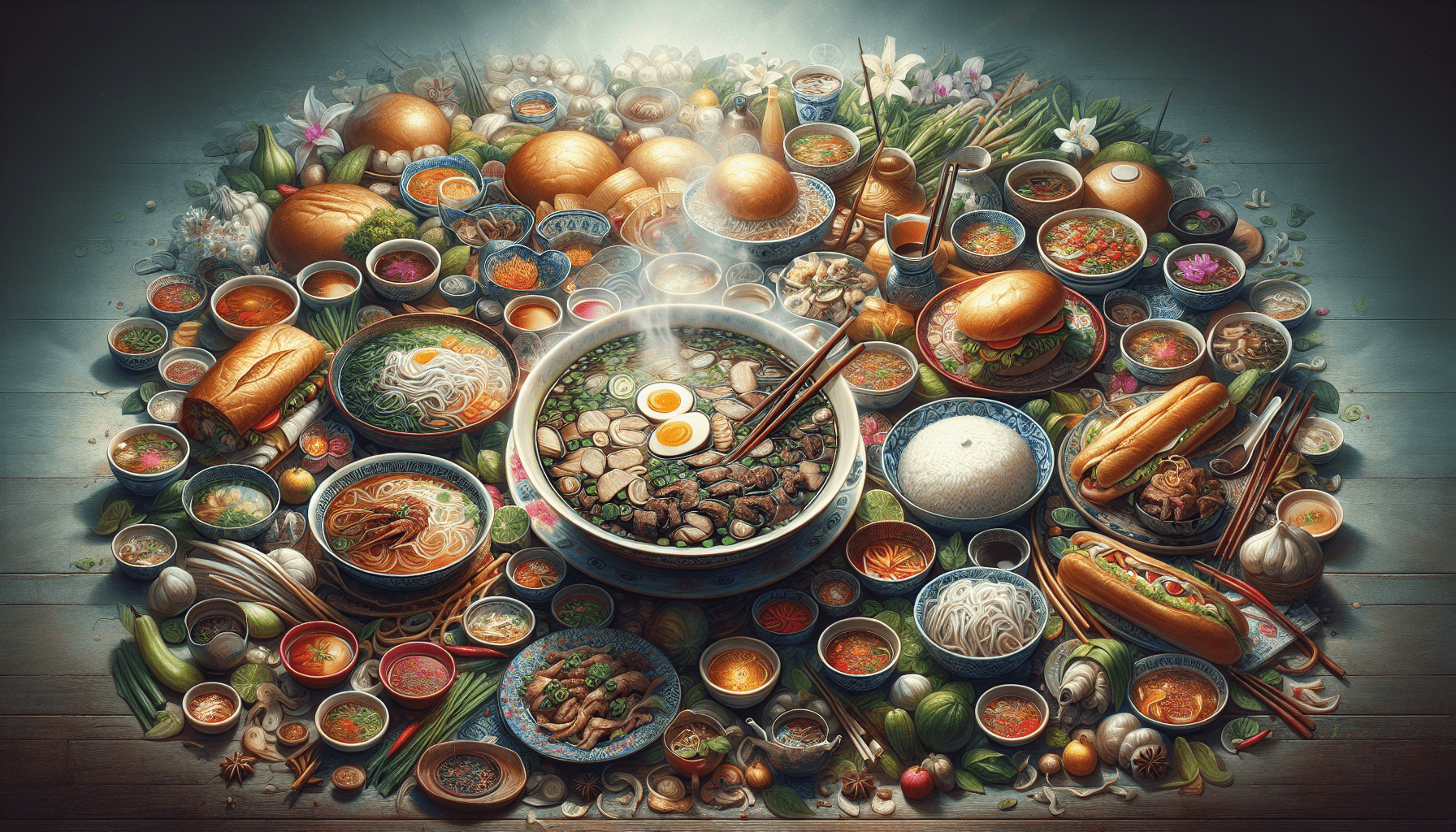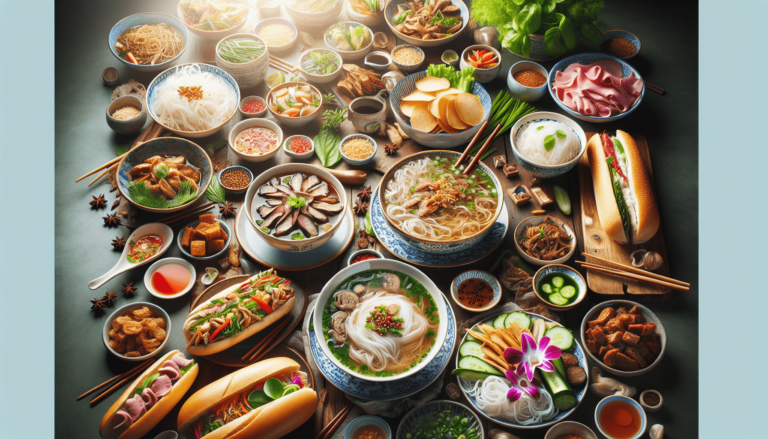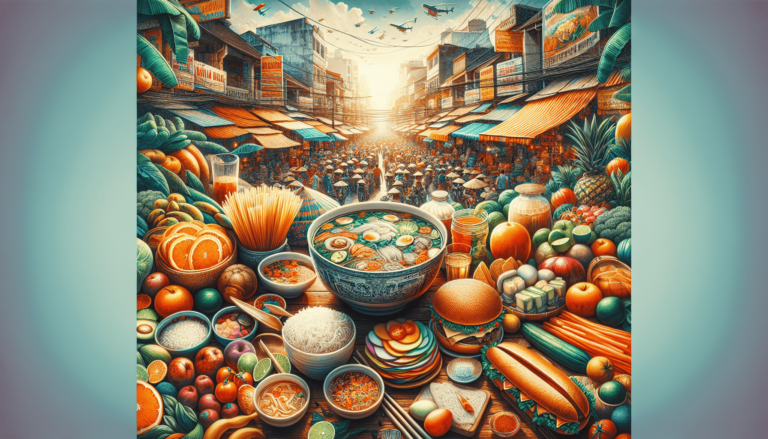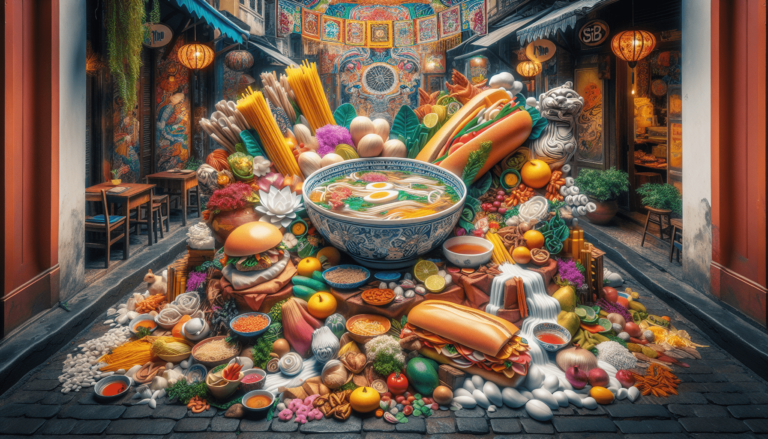Vietnamese cuisine is renowned for its vibrant flavors, fresh ingredients, and unique cooking techniques. From the bustling streets of Hanoi to the tranquil villages of the Mekong Delta, the cooking methods in Vietnam are a true reflection of the country’s rich culinary history. Whether it’s the delicate art of stir-frying, the aromatic wonders of steaming, or the slow simmering of soups, Vietnamese cooking embraces a harmonious blend of simplicity and complexity. So, if you’re eager to discover the secrets behind Vietnam’s mouthwatering dishes, make sure to experience the authentic flavors at one of the Eurasian Bistro locations in Pensacola.
Overview of Vietnamese Cuisine
Vietnamese cuisine is known for its vibrant flavors, balance of fresh ingredients, and various cooking methods that bring out the best in each dish. There are several unique elements of Vietnamese culture that shape the culinary traditions of this diverse country. From the distinct flavor combinations to the emphasis on fresh ingredients and simmered dishes, Vietnamese cuisine offers a delightful culinary experience.
Unique Elements of Vietnamese Culture
Vietnamese culture plays a significant role in shaping the country’s cuisine. The food reflects the rich history, diverse landscapes, and influences from neighboring countries. With its French colonial past and proximity to China, Vietnam has developed a unique fusion of flavors and cooking techniques.
The emphasis on fresh ingredients is a distinctive element in Vietnamese cuisine. The country’s warm climate enables the cultivation of an abundance of herbs, spices, vegetables, and tropical fruits. The Vietnamese people value freshness and believe that it enhances the flavor and nutritional value of their dishes.
Another unique aspect of Vietnamese culture is the concept of balance. Vietnamese cuisine aims to achieve a harmonious balance between different flavors, textures, and colors in a single dish or a complete meal. This balance is achieved by combining ingredients that are sweet, sour, salty, spicy, and bitter, creating a complex and satisfying flavor profile.
Distinct Flavors Combination
Vietnamese cuisine is renowned for its distinct flavor combinations that tantalize the taste buds. The dishes often incorporate a blend of aromatic herbs, spices, sauces, and condiments to create a harmonious symphony of flavors.
One classic example of distinct flavor combination is the famous Vietnamese dipping sauce, nước mắm. Made from fermented fish sauce, lime juice, sugar, garlic, and chili, this sauce adds a perfect balance of sweet, salty, and tangy flavors to various dishes.
The use of fresh herbs like mint, cilantro, basil, and lemongrass is also prevalent in Vietnamese cuisine. These herbs not only add a refreshing element but also infuse dishes with vibrant aromas and flavors.
Additionally, Vietnamese cuisine often incorporates a variety of condiments such as chili paste, hoisin sauce, and soy sauce, which further enhance the flavor profile of the dishes.

Balance Between Fresh Ingredients and Simmered Dishes
Vietnamese cuisine strikes a harmonious balance between dishes that showcase fresh ingredients and those that are simmered for hours to extract deep flavors.
Fresh ingredients are celebrated in dishes like the famous Vietnamese salad, Gỏi cuốn. These fresh spring rolls are filled with a delightful combination of herbs, vegetables, and sometimes shrimp or meat, all wrapped in translucent rice paper. The freshness of the ingredients shines through, creating a light and healthy dish.
On the other hand, simmering is a technique used to create rich and flavorful dishes. Vietnamese soups, such as Phở and Bún bò Huế, are classic examples of simmered dishes. The slow-cooking process allows the flavors of the ingredients to meld together, resulting in a comforting and deeply satisfying bowl of soup.
The marination process is another key aspect in Vietnamese simmered dishes. Meats and seafood are often marinated in a blend of aromatic spices, herbs, and sauces for hours or even overnight, allowing the flavors to penetrate deeply and create a mouthwatering result.
Pan-frying
Pan-frying is a popular cooking method in Vietnamese cuisine, offering a delicious combination of crispiness and flavor. It is commonly used for meats and vegetables, resulting in dishes that are both visually appealing and tasty.
One classic dish that showcases pan-frying is tofu sûr-loing. Cubes of tofu are pan-fried until golden and crispy, creating a delightful contrast in textures. It is often served with a tangy dipping sauce, complementing the crispy exterior and soft interior of the tofu.
Grilled pork strips are another popular pan-fried dish. Thinly sliced pork is marinated in a blend of herbs, spices, and sauces, then pan-fried to perfection. The result is tender and flavorful meat with a caramelized exterior.
Fried rice is also commonly prepared by pan-frying. Cooked rice is stir-fried with various vegetables, meats, and seasonings, resulting in a fragrant and savory dish that is a staple in Vietnamese cuisine.
Steaming
Steaming is a cooking method used in Vietnamese cuisine to create light and healthy dishes. It is particularly popular in dishes like Bánh Bao (Vietnamese Steamed Bun), Bánh Cuốn (Vietnamese Rice Rolls), and steamed seafood dishes.
Bánh Bao is a traditional Vietnamese steamed bun filled with a delicious combination of meats, vegetables, and sometimes quail eggs. The soft and fluffy bun is achieved through the steaming process, preserving the moisture and tenderness of the filling.
Bánh Cuốn, or Vietnamese Rice Rolls, are delicate and translucent rolls made from steamed rice batter. They are typically filled with a savory mixture of minced pork, mushrooms, and aromatic herbs. Steaming ensures that the rice rolls are supple and slightly sticky, perfect for dipping into nước mắm or soy sauce.
Steamed seafood dishes, such as steamed fish or crab, highlight the natural flavors of the seafood. The gentle steam cooks the seafood to perfection, resulting in tender and succulent meat that is enhanced by the subtle aromatics used in the steaming process.

Stewing
Stewing is a slow-cooking technique used in Vietnamese cuisine to develop deeper flavors in dishes. It involves simmering ingredients over low heat for an extended period, allowing the flavors to meld together and creating rich and hearty dishes.
Phở, the iconic Vietnamese noodle soup, is a classic example of a stewed dish. The broth is prepared by simmering beef bones, spices, and herbs for several hours, resulting in a flavorful and aromatic base for the soup. Tender slices of beef or chicken, rice noodles, and an assortment of herbs and vegetables complete this beloved dish.
Another popular stewed dish is Bún bò Huế, a spicy beef and noodle soup originating from the city of Huế. The intense and robust flavors of this dish are achieved through the slow-cooking process, allowing the beef bones and spices to infuse the broth with their savory goodness.
Marination plays a crucial role in Vietnamese stews. Meats and seafood are often marinated in a blend of spices, herbs, and sauces before being added to the simmering broth. This step imparts additional layers of flavor to the final dish, making each bite a delight for the taste buds.
Grilling
Grilling is a common cooking method in Vietnamese cuisine, adding a smoky and charred flavor to meats and seafood. It is a popular technique used to create dishes like Thịt nướng (grilled meat) and Bò Lá Lốt (beef wrapped in wild betel leaf).
Thịt nướng refers to grilled meat, which is marinated in a blend of fish sauce, garlic, lemongrass, and other aromatic ingredients. The marinated meat is then grilled over an open flame, resulting in tender, juicy, and flavorful meat with a slight char that adds depth to the overall dish.
Bò Lá Lốt, a unique dish, involves wrapping seasoned ground beef in wild betel leaves before grilling. The leaves impart a distinct flavor to the meat as they cook, creating a delicious and aromatic bite.
Grilling is not limited to meats alone in Vietnamese cuisine. Seafood such as prawns, squid, and fish are also commonly grilled, showcasing the natural sweetness and delicate flavors of the seafood.
Simmering
Simmering is a popular preparation technique in Vietnamese cuisine, particularly in the creation of soups. It involves cooking ingredients over low heat for an extended period, resulting in a flavorful and comforting dish.
Canh Chua, or sour soup, is a traditional Vietnamese soup that highlights the simmering technique. The soup is prepared by simmering a combination of sour fruits like tamarind, pineapple, or tomatoes with various vegetables, herbs, and seafood. The slow cooking process allows the flavors to meld together, creating a harmonious balance of sweet, sour, and savory notes.
Phở, the beloved Vietnamese noodle soup, also utilizes simmering to create its signature flavors. The broth is prepared by simmering bones, meat, and aromatic spices for hours, resulting in a rich and fragrant base for the soup. The slow simmering process extracts the essence of the ingredients, yielding a comforting and flavorful bowl of noodles.
Simmering is a versatile technique that can be applied to a wide range of ingredients and dishes in Vietnamese cuisine. It is a method that requires patience and time but rewards the palate with deep and satisfying flavors.
Deep-frying
Deep-frying is a cooking method employed in Vietnamese cuisine to create crispy and indulgent dishes. The golden exterior and the satisfying crunch of deep-fried foods are beloved in Vietnamese cuisine.
Crispy Spring Rolls, or Chả Giò, are a popular example of deep-fried delicacies. These rolls are made by wrapping a mixture of vegetables, meat, and/or seafood in rice paper or wheat wrappers and then frying them until they turn golden and crispy. The result is a flavorful and addictive appetizer, often served with lettuce, fresh herbs, and dipping sauces.
Bánh rán, a sesame ball, is another delicious treat that showcases deep-frying. Made from glutinous rice flour and filled with sweet mung bean paste, these bite-sized balls are deep-fried until they develop a crunchy exterior and a soft, gooey interior. The distinctive aroma of sesame adds an extra layer of flavor to this delightful snack.
Bánh cam, or orange cake, is also deep-fried to perfection. These crispy golden balls have a crispy exterior and a sweet, fragrant filling made from sweetened mung bean paste. The contrast between the crispy shell and the creamy filling makes it a popular choice for dessert.
Blanching
Blanching is a cooking method often used in Vietnamese cuisine to quickly cook vegetables and herbs before using them in dishes. It involves briefly boiling the ingredients and then plunging them into cold water to stop the cooking process, resulting in vibrant and crisp textures.
Blanched vegetables and herbs are commonly used in Vietnamese salads and fresh spring rolls, adding a refreshing and crunchy element to the dishes. The blanching process helps to preserve the vibrant colors and nutritional value of the vegetables while enhancing their texture.
Key herbs like mint, basil, and cilantro are frequently blanched to remove any bitterness and intensify their flavors. The blanched herbs add a burst of freshness and aroma to various Vietnamese dishes, including soups, noodle dishes, and stir-fries.
Blanching is a quick and simple technique that ensures the vegetables and herbs retain their natural qualities, making them a delightful addition to Vietnamese cuisine.
Braising
Braising is a cooking method that combines frying and stewing, resulting in tender and flavorful dishes. In Vietnamese cuisine, braised dishes like Caramel fish, chicken, and pork are highly regarded for their depth of flavors.
Caramel fish, or Cá Kho Tộ, is a popular Vietnamese dish that exemplifies the braising technique. Fish, typically catfish or snakehead fish, is simmered in a caramel-based sauce made from fish sauce, sugar, and aromatics like garlic and shallots. The slow-cooking process allows the fish to absorb the rich and savory flavors, resulting in a succulent and caramelized dish.
Chicken and pork are also commonly braised in Vietnamese cuisine. The meats are first seared in a hot pan to create a flavorful crust, then simmered in a broth or sauce until tender. This method ensures that the meats are infused with the flavors of the marinade and become incredibly tender and delicious.
Braising is a versatile technique that can be applied to various meats and proteins, offering a depth of flavors that is highly valued in Vietnamese cuisine.
Fermenting
Fermenting is a traditional method used in Vietnamese cuisine to create flavorful sauces and pastes. Fermentation is a natural process that enhances the flavors and develops complex umami notes in the ingredients.
Nước Mắm, or fish sauce, is a quintessential condiment in Vietnamese cuisine, made through the fermentation of salted fish. This unique sauce adds a depth of flavor and saltiness to dishes, often used in marinades, dressings, and dipping sauces.
Fermented bean paste and shrimp paste, known as tương and mắm ruốc, respectively, are also widely used in Vietnamese cuisine. These pastes are made by fermenting beans or shrimp with salt, resulting in intense and savory condiments that enhance the flavors of various dishes.
The fermentation process adds layers of complexity and umami to Vietnamese cuisine, making it a key element in creating dishes with rich and nuanced flavors.
In conclusion, Vietnamese cuisine showcases a wide range of cooking methods that highlight the country’s diverse culinary traditions. From the popular techniques of pan-frying and grilling to the comforting methods of stewing and simmering, each cooking method brings its unique flavors and textures to Vietnamese cuisine. The emphasis on fresh ingredients, distinct flavor combinations, and the balance between simplicity and complexity make Vietnamese cuisine a delightful and satisfying culinary experience. So, whether you visit a Vietnamese restaurant or try your hand at cooking traditional Vietnamese dishes at home, be prepared to embark on a flavorful journey through the vibrant world of Vietnamese cuisine.







